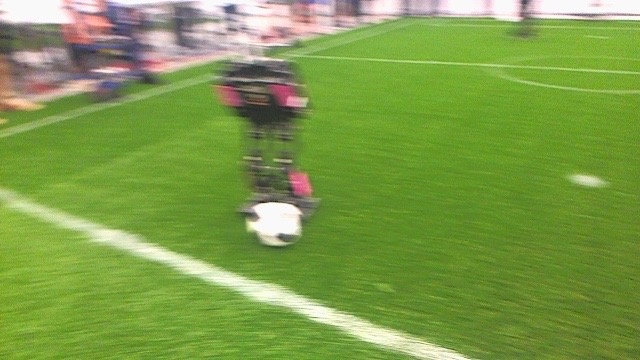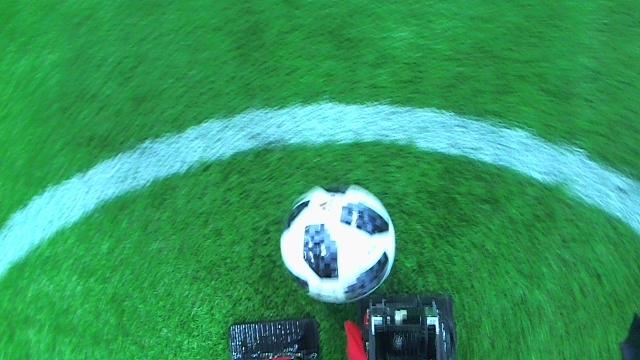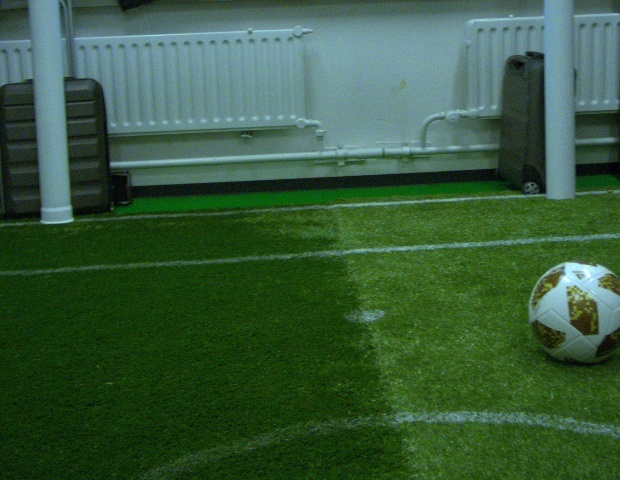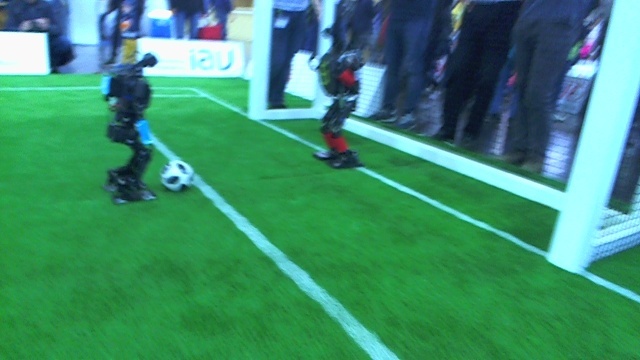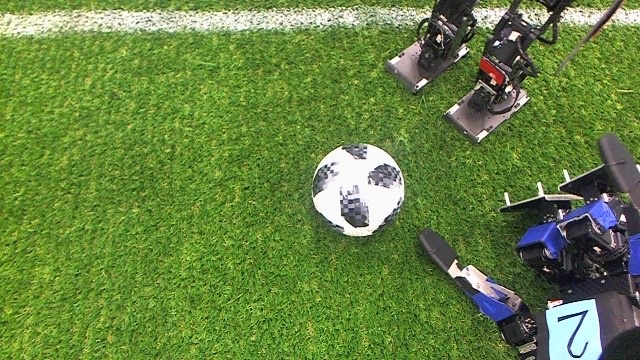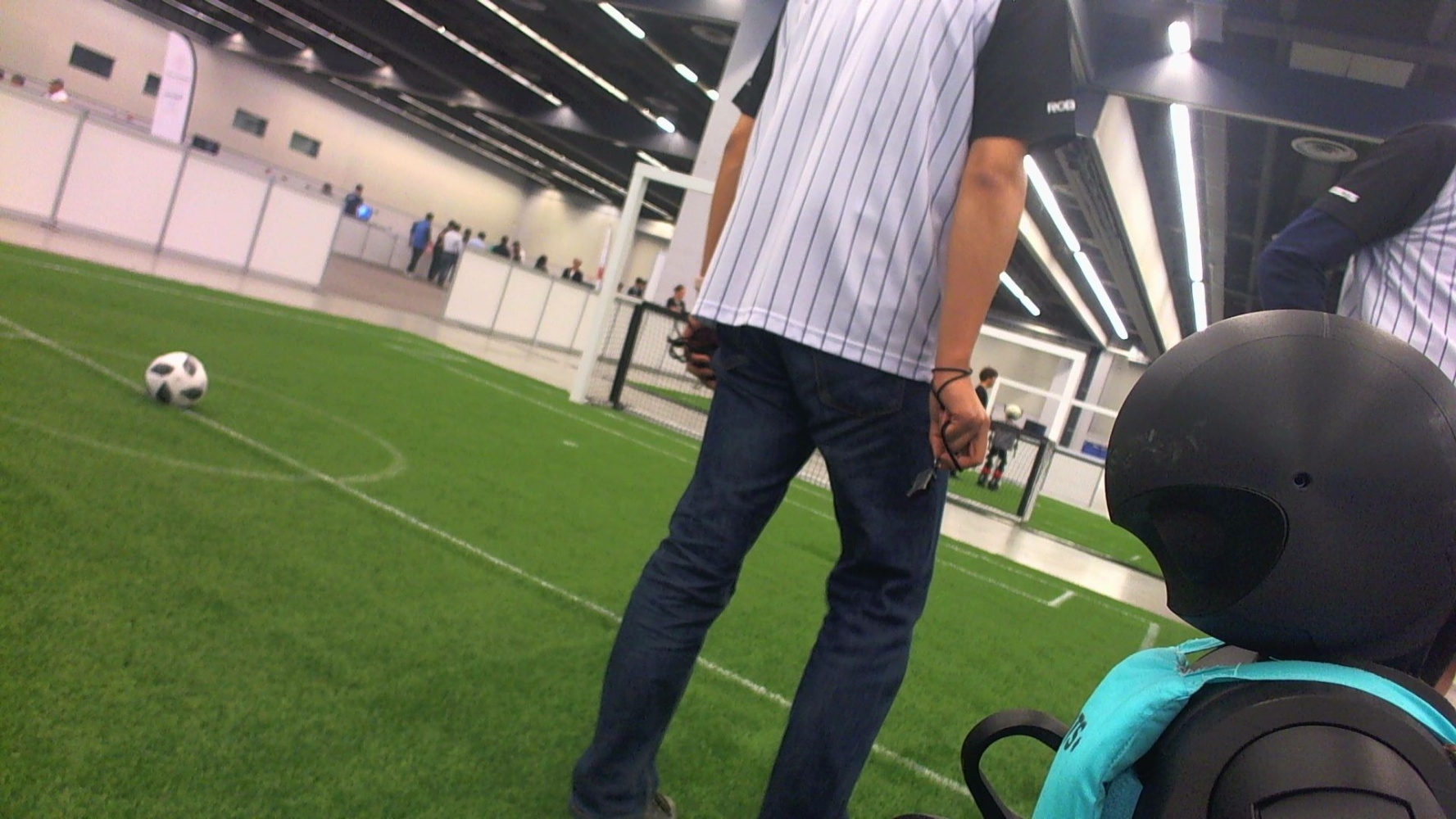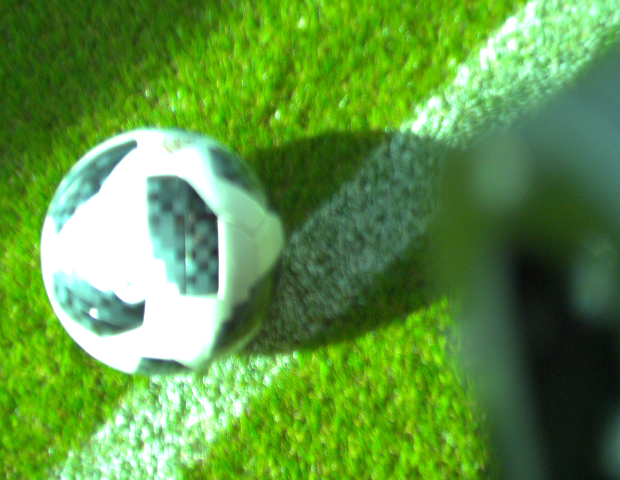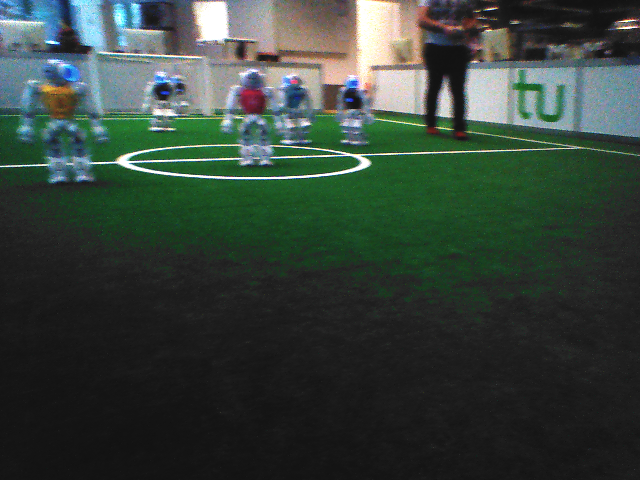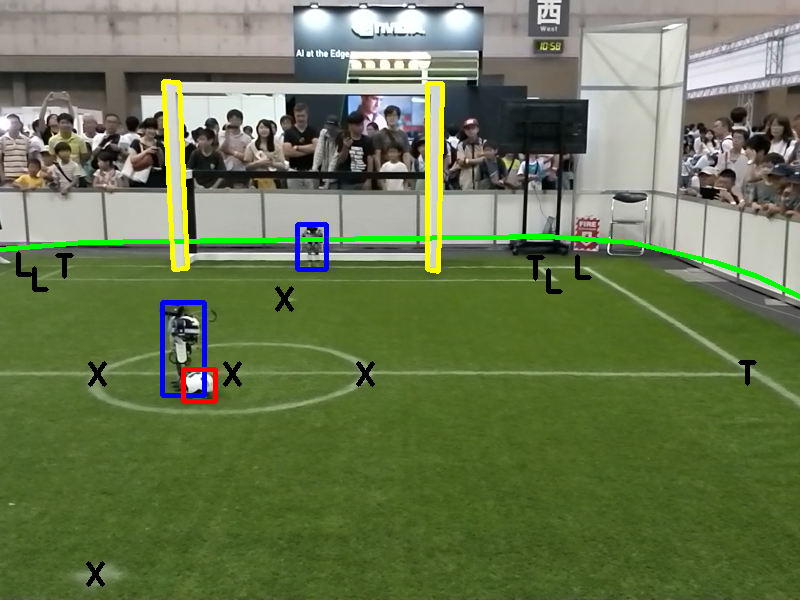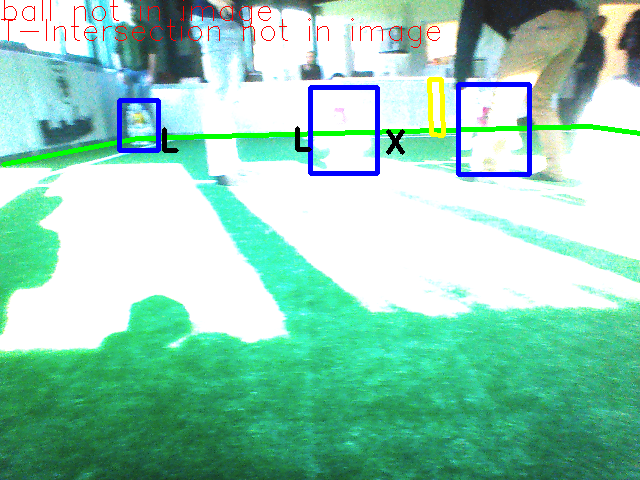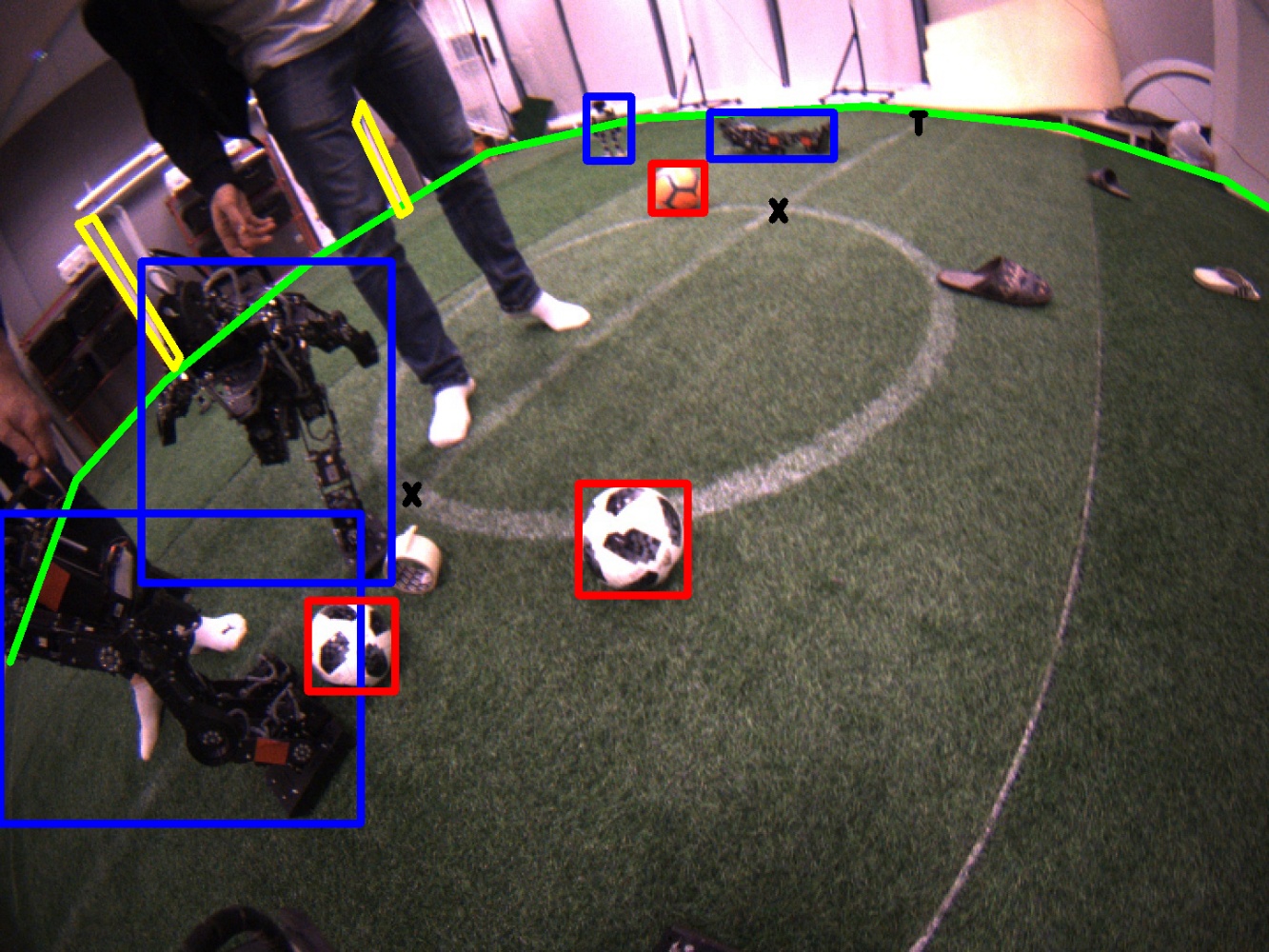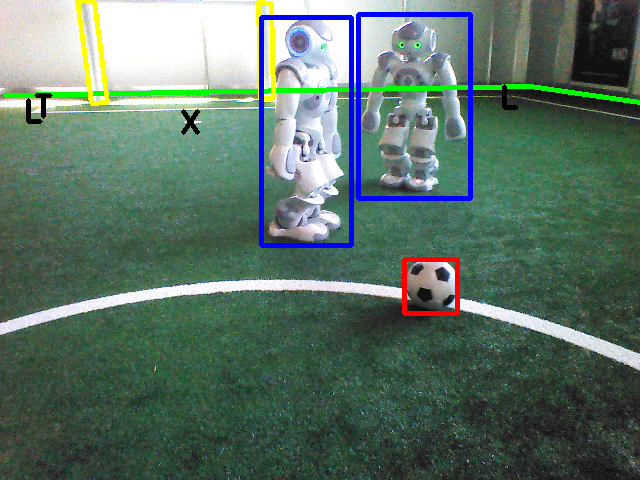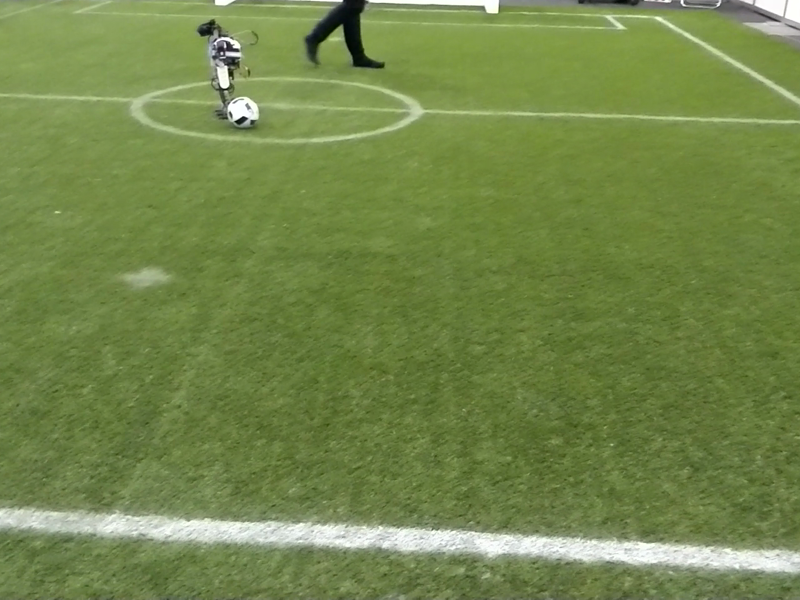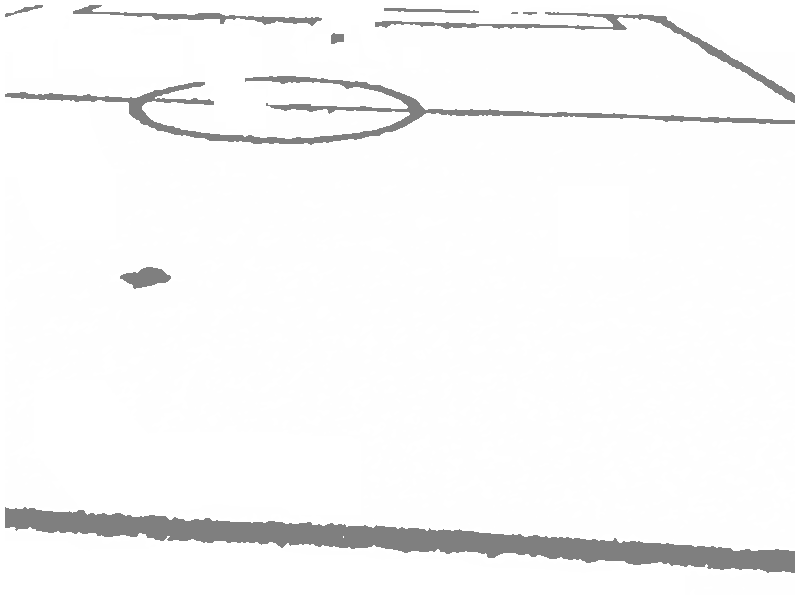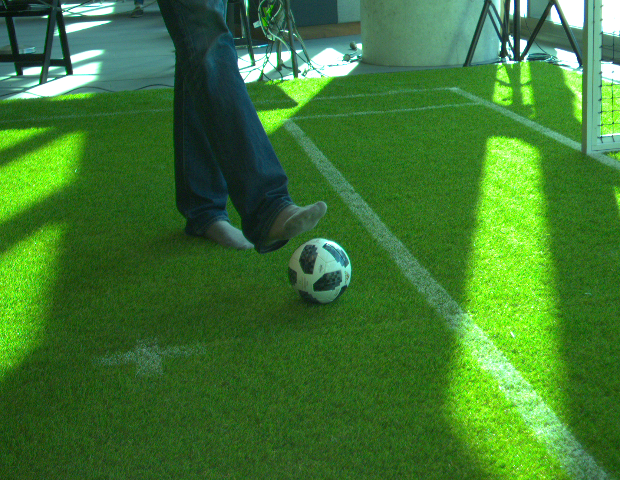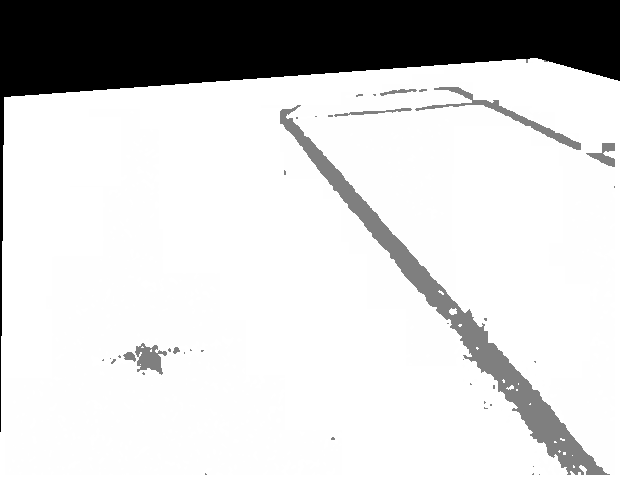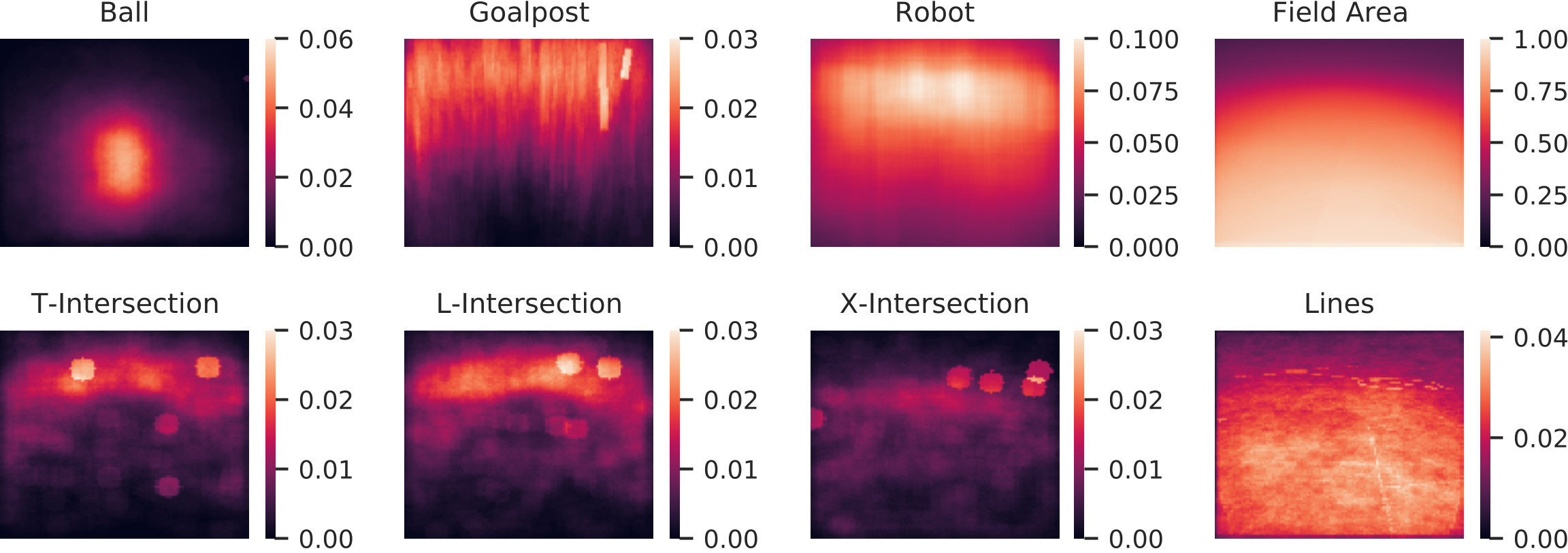This repository contains the scripts and additional information for the TORSO-21 Dataset. This is a dataset for the RoboCup Humanoid Soccer domain consisting of images of the Humanoid League as well as the Standard Platform League. We provide two image collections. The first one consists of images from various real-world locations, recorded by different robots. It includes annotations for the ball, goalposts, robots (including team color and player number), lines, field edge, and three types of line intersections. The second collection is generated in the Webots simulator which is used for the official RoboCup Virtual Humanoid Soccer Competition. Additionally to the labels of the first collection, labels for the complete goal, depth images, 6D poses for all labels, as well as the camera location in the field of play, are provided.
| # of Images | 10464 |
|---|---|
| # of Balls | 6081 |
| # of Robots | 7641 |
| # of Goalposts | 7888 |
| # of L-Intersections | 10375 |
| # of T-Intersection | 8659 |
| # of X-Intersections | 7268 |
| # of Field Segmentations | 10464 |
| # of Line Segmentations | 10464 |
| Robot Team Colors | |
|---|---|
| # of Blue Robots | 1277 |
| # of Red Robots | 1917 |
| # of Unknown Robots | 4447 |
| Robot Player Numbers | |
|---|---|
| # of Robots w/out # | 6526 |
| # of Robots with #1 | 229 |
| # of Robots with #2 | 162 |
| # of Robots with #3 | 276 |
| # of Robots with #4 | 309 |
| # of Robots with #5 | 42 |
| # of Robots with #6 | 97 |
# of simulated images: 24.000
With annotations marked
With segmentations of lines and field
With annotations, segmentation mask and depth image
The images and annotations can be downloaded here: https://data.bit-bots.de/TORSO-21/
The data can also be downloaded with the following script (use --help for further options):
./scripts/download_dataset.py --allIf you want to train a YOLO, you can use the script provided in this repository to generate the labels.
The repository structure is as follows:
├── data # contains the annotations and images
│ ├── reality # the images recorded in reality
│ │ ├── train # the training set
│ │ │ ├── annotations.yaml # the annotations in yaml format
│ │ │ ├── images/ # a folder containing all the images of the training set
│ │ │ └── segmentations/ # a folder containing all the segmentation masks of the training set
│ │ └── test # the test set
│ │ └── ... # it is structured in the same way as the training set
│ └── simulation # the images recorded in simulation
│ ├── train # the training set
│ │ ├── annotations.yaml # the annotations in yaml format
│ │ └── depth/ # a folder containing all the depth images of the training set
│ │ ├── images/ # a folder containing all the images of the training set
│ │ └── segmentations/ # a folder containing all the segmentation masks of the training set
│ └── test # the test set
│ └── ... # it is structured in the same way as the training set
└── scripts # some useful scripts, see below for details
└── ...
The annotations are in the following format:
images:
130-16_02_2018__11_16_34_0000_upper.png:
width: 1920
height: 1080
annotations:
- blurred: true
color: unknown # possible values {blue, red, unknown}
concealed: false
in_image: true
number: null # possible values {null, 1, 2, 3, 4, 5, 6}
type: robot
vector:
- - 42 # x value
- 26 # y value
- - 81
- 98
pose: # The pose of the annotated object, only available in simulation
position:
x: 0
y: 0
z: 0
orientation:
x: 0
y: 0
z: 0
w: 0
motion: standing
- in_image: false
type: ball
metadata: # The keys should be like this but do not need to be present for all images
fov: 42
location: "foobay"
tags: ["natural_light", "telstar18", "do_not_use"]
imageset_id: 130
camera_pose: # The pose of the annotated object, only available in simulation
position:
x: 0
y: 0
z: 0
orientation:
x: 0
y: 0
z: 0
w: 0
Natural light: False
League: HSL
...Follow these instructions to set up the dependencies for the scripts used for visualization and creation of the dataset.
-
Install the package manager Poetry as described here. This prevents dependency conflicts and ensures that the correct versions of the dependencies are installed.
-
Clone the repository:
git clone https://github.com/bit-bots/TORSO_21_dataset.git
-
Move into the repository and install the dependencies
-
without optional dependencies (for dataset creation):
cd TORSO_21_dataset && poetry install --without=dev --no-root
-
with optional dependencies (for dataset creation):
cd TORSO_21_dataset && poetry install --no-root
-
To run the tools you need to enter the poetry environment:
poetry shellAlternatively, you can use poetry run ./scripts/<file> to run the scripts without sourcing.
To visualize the annotations, run the following two commands to pickle and show the annotations in the poetry environment:
./scripts/pickle_annotations.py data/reality/train/annotations.yaml
./scripts/viz_annotations.py data/reality/train/annotations.pklGenerates metadata statistics from an annotations file, i.e. how often which metadata type occurs.
This script is used to generate statistics about the annotations, i.e. how often each annotation occurs per image. Its first argument is the annotation file to generate annotations for.
Sanity-checks the annotations, i.e. checks if some labels are marked as in image and not in image and if the field boundary is contained.
Simple script that runs a YOLO model against the test dataset and calculates the IOU metrics.
./scripts/yolo_eval.py --yolo-path /path/to/yolo_folder --collection data/reality/test
To use these scripts, make sure to install all dependencies with poetry install (see Set up environment).
This script downloads multiple image sets and annotations from the ImageTagger.
The imagesets and the annotation format are defined at the top of the file.
Its output is a folder data_raw in the root of this repository that contains all image files.
To avoid conflicting names, every filename is prepended with its dataset id.
Additionally, a file annotations.yaml is created that contains a dict mapping set ids to their
metadata and a dict mapping image names to their labels.
This is just a verbatim copy of the ImageTagger download script. Its API is used by
download_and_merge_data.py, it it not necessary to use this script directly.
This script filters the annotations contained in data_raw/annotations.yaml to only include the
images in the data folder and creates a data/annotations.yaml file.
This script prepares the files in data for the ImageTagger, i.e. zips the images and converts the
annotations to the upload format.
This script can be used to label lines.
This script converts labels from the Pascal VOC XML format to the yaml format as defined above.
Creates the file data/annotations_with_metadata.yaml from data/annotations.yaml and
data/metadata.csv. annotations.yaml can be downloaded from the ImageTagger, metadata.csv has
to be manually created.
This script was used to resolve an issue regarding the segmentation images of the reality collection.
This fixes the issue of incorrect color values of the class field caused by anti-aliasing and a old bug in the line_label_tool.
The variational autoencoder, we have used, is based on noctrog's conv-vae.
The training code for the autoencoder is located in scripts/vae/.
This file runs the training of the vae.
More details are avalible by running vae/train.py -h.
This script runs the autoencoder on a given input and shows the reconstruction of the image.
More details are available by running vae/reconstruct.py -h.
This script runs the vae recursively on all image inside a given folder and saves their latent space representation und reconstruction errors inside a file.
More details are available by running vae/embeddings.py -h.
Plots n'th neighbors in the latent space of a given image.
More details are available by running vae/distances.py -h.
Creates a yaml file containing three lists containing:
- The images that survived the pruning
- The images that got selected due to the high reconstruction error
- The images that will be removed from the dataset
More details are available by running vae/duplicates.py -h.
Loads an embeddings file and plots the reconstruction errors.
The PyTorch model definition.
The PyTorch dataset definition.
| # | Layer (type) | Output Shape | Param # |
|---|---|---|---|
| Input | (3, 128, 112) | 0 | |
| 1 | Conv2d | (32, 64, 56) | 896 |
| 2 | BatchNorm2d | (32, 64, 56) | 64 |
| 3 | LeakyReLU | (32, 64, 56) | 0 |
| 4 | Conv2d | (64, 32, 28) | 18,496 |
| 5 | BatchNorm2d | (64, 32, 28) | 128 |
| 6 | LeakyReLU | (64, 32, 28) | 0 |
| 7 | Conv2d | (64, 16, 14) | 36,928 |
| 8 | BatchNorm2d | (64, 16, 14) | 128 |
| 9 | LeakyReLU | (64, 16, 14) | 0 |
| 10 | Conv2d | (64, 8, 7) | 36,928 |
| 11 | BatchNorm2d | (64, 8, 7) | 128 |
| 12 | LeakyReLU | (64, 8, 7) | 0 |
| 13 | Linear | (300) | 1,075,500 |
| 14 | LeakyReLU | (300) | 0 |
| 15 | Dropout | (300) | 0 |
| 16 | Linear | (300) | 1,075,500 |
| 17 | LeakyReLU | (300) | 0 |
| 18 | Dropout | (300) | 0 |
| 19 | Linear | (3584) | 1,078,784 |
| 20 | LeakyReLU | (3584) | 0 |
| 21 | Dropout | (3584) | 0 |
| 22 | UpsamplingNearest2d | (64, 16, 14) | 0 |
| 23 | ConvTranspose2d | (64, 16, 14) | 36,928 |
| 24 | BatchNorm2d | (64, 16, 14) | 128 |
| 25 | LeakyReLU | (64, 16, 14) | 0 |
| 26 | psamplingNearest2d | (64, 32, 28) | 0 |
| 27 | ConvTranspose2d | (64, 32, 28) | 36,928 |
| 28 | BatchNorm2d | (64, 32, 28) | 128 |
| 29 | LeakyReLU | (64, 32, 28) | 0 |
| 30 | UpsamplingNearest2d | (64, 64, 56) | 0 |
| 31 | ConvTranspose2d | (32, 64, 56) | 18,464 |
| 32 | BatchNorm2d | (32, 64, 56) | 64 |
| 33 | LeakyReLU | (32, 64, 56) | 0 |
| 34 | UpsamplingNearest2d | (32, 128, 112) | 0 |
| 35 | ConvTranspose2d | (3, 128, 112) | 867 |
| 36 | Sigmoid | (3, 128, 112) | 0 |
The code for generating the simulation data can be found here https://github.com/bit-bots/wolfgang_robot/blob/feature/recognition/wolfgang_webots_sim/src/wolfgang_webots_sim/webots_camera_controller.py
Visualization of the position density of the respective annotations in the image space over all images of the real-world collection:
When you use our dataset or related software, please cite it as follows:
Abstract
We present a dataset specifically designed to be used as a benchmark to compare vision systems in the RoboCup Humanoid Soccer domain.
The dataset is composed of a collection of images taken in various real-world locations as well as a collection of simulated images.
It enables comparing vision approaches with a meaningful and expressive metric.
The contributions of this paper consist of providing a comprehensive and annotated dataset, an overview of the recent approaches to vision in RoboCup, methods to generate vision training data in a simulated environment, and an approach to increase the variety of a dataset by automatically selecting a diverse set of images from a larger pool.
Additionally , we provide a baseline of YOLOv4 and YOLOv4-tiny on this dataset.
@inproceedings{TORSO2021,
author = {Bestmann, Marc and Engelke, Timon and Fiedler, Niklas and Güldenstein, Jasper and Gutsche, Jan and Hagge, Jonas and Vahl, Florian},
year = {2021},
title = {{TORSO-21 Dataset: Typical Objects in RoboCup Soccer 2021}},
booktitle={RoboCup 2021: Robot World Cup XXIV}
}NOTE: You can get various citation types in the right sidebar on GitHub "Cite this repository"...
- Replacement of the segmentations in the reality collection (using the
fix_segmentations.py). The update towards the publication introduced incorrect color values of the field class in the segmentation images.
- Publication
